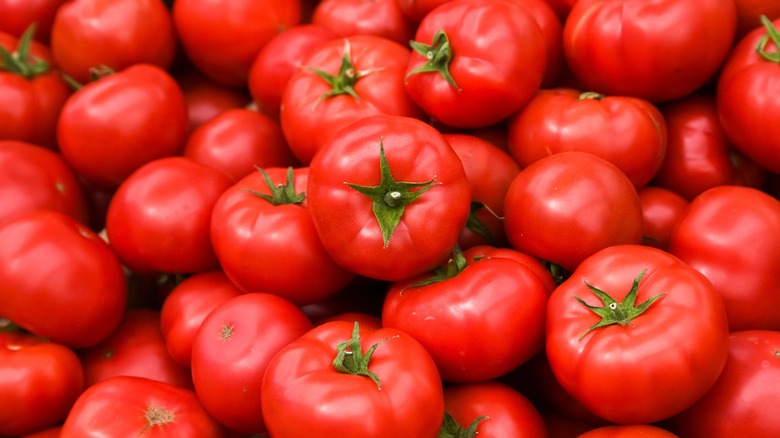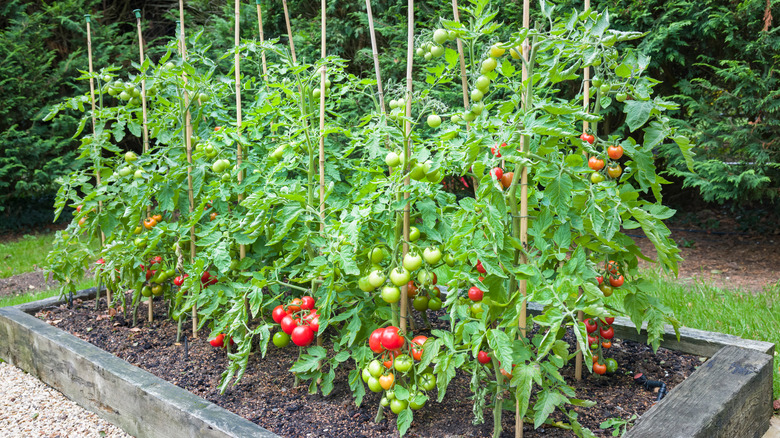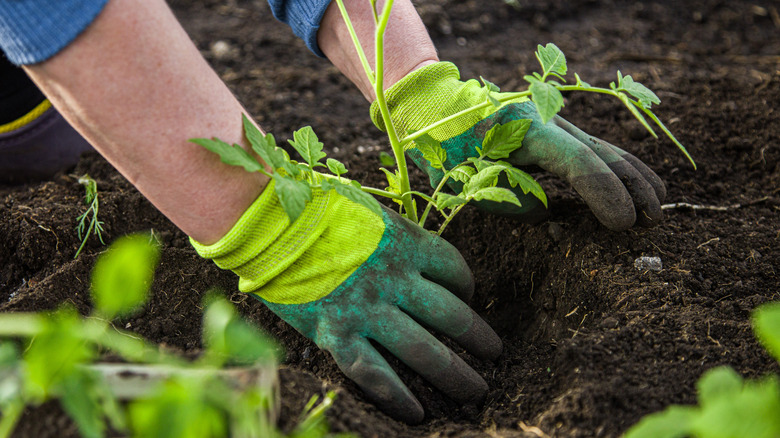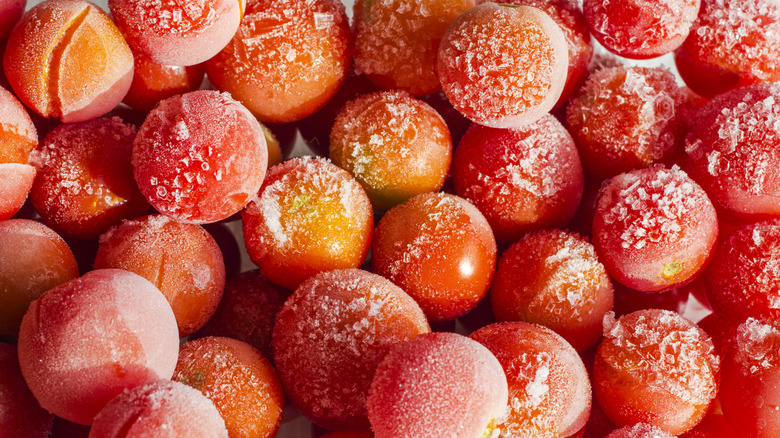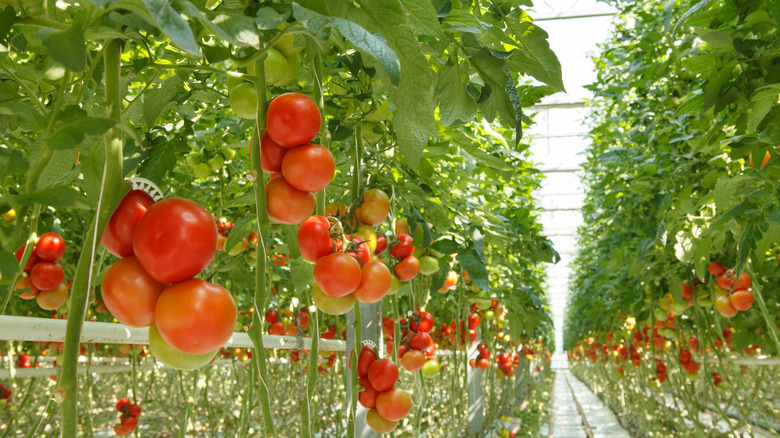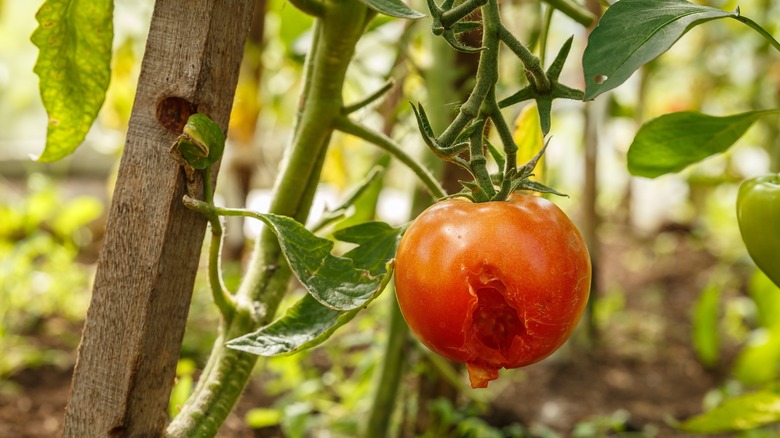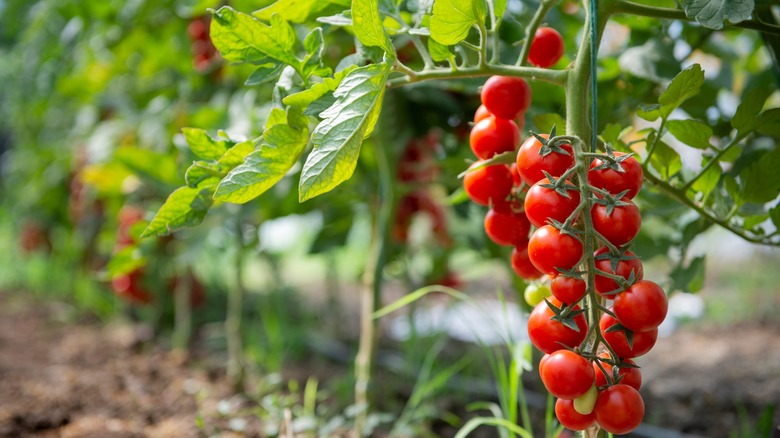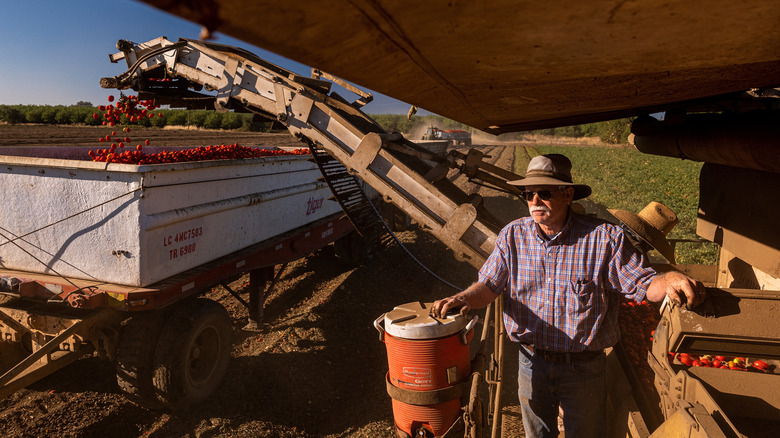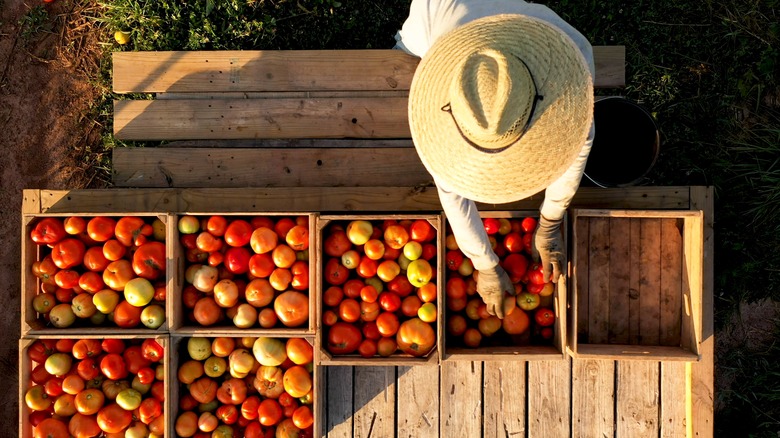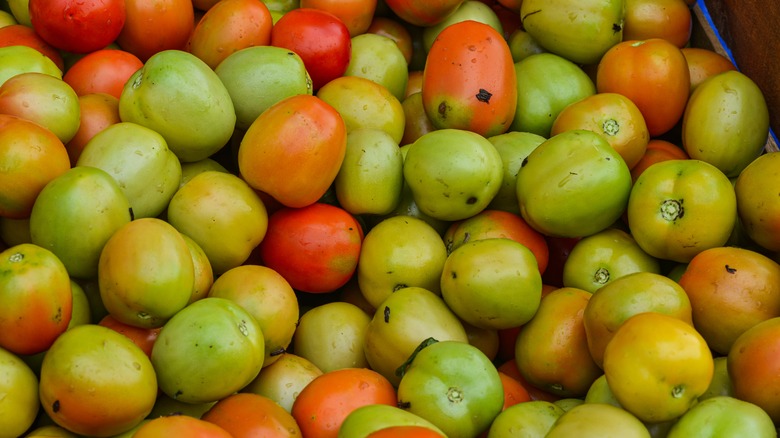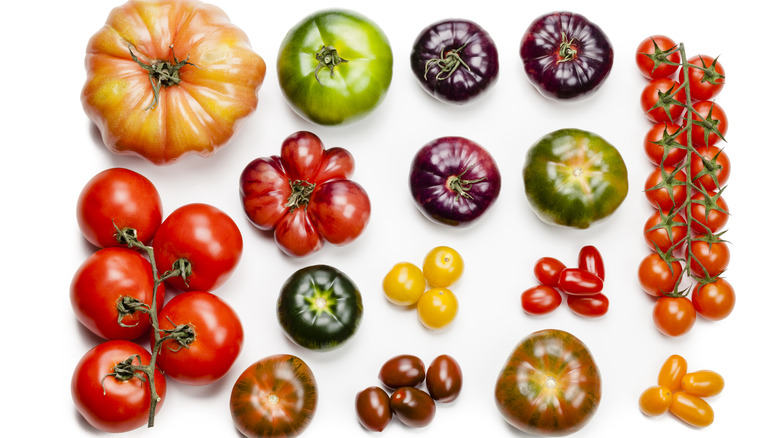How Tomatoes Make It To Your Dinner Plate
Whether they're combined with sugar and spices into one of America's favorite condiments — ketchup — or simply sliced and served fresh with a sprinkle of salt, tomatoes are omnipresent on dinner plates. But tomatoes have a rich and somewhat convoluted history – they were revered by the Mayans, denigrated as poisonous in Europe, and likely only arrived in North America by way of a redundant journey across the Atlantic and back again.
The very word "tomato" comes from the Aztec word xitomatl and belies the fruit's origins in the Americas. The first Europeans to encounter tomatoes were the Spanish, who brought them back from Mexico in the 1520s and introduced them far and wide, paving the way for their adoption by not just European but Asian cuisines. In Europe specifically, tomatoes developed a reputation of being poisonous, in large part due to their membership in the nightshade family, of which the only member native to Europe, belladonna, is indeed poisonous. They had nevertheless become popular in Italy by the 17th century and in France by the 18th, and in the early 19th century, they were beloved in North America.
Tomatoes today are known for their myriad health benefits, including increased immunity, not to mention for their delightful flavor. Today, some 10,000 varieties of tomatoes are grown, offering a wide variety of colors and flavors.
They come in two major forms: determinate and indeterminate
There may be thousands of different kinds of tomato, but they only fall into two major categories: cordon (also known as indeterminate) and bush (also known as determinate). Most slicing tomatoes are indeterminate tomatoes, while most paste tomatoes, sauce tomatoes, and canning tomatoes are determinate tomatoes.
The difference lies in the way in which the plants grow. The former grow tall — up to six feet — and tend to produce multiple harvests a year, while the latter grow shorter and wider and tend to produce their bounty all at once. Cordon tomatoes are a more difficult crop, requiring more space and regular maintenance plus vertical physical support from bamboo cane, trellises, or cages. They tend to need more space — about three feet between each plant. Determinates, meanwhile, can be just two feet apart, and the fact that they grow smaller and shorter than tall cordon tomatoes makes them perfect for smaller gardens or even hanging baskets, as the stems can grow over the sides with no support needed.
They're particular about their soil
One common mistake when growing tomatoes is attempting to plant them in the wrong type of soil. Tomatoes grow best in slightly acidic soil with a pH of somewhere between 6.2 and 6.8. They need a constant supply of nutrients and react poorly when under-nourished; diseases like blossom end rot can surface when the plant isn't getting enough calcium, for example. For home gardeners, compost can help provide minor nutrients, while fertilizer can add major nutrients. But it's no surprise that tomatoes thrive best in certain climates — for instance, on the outskirts of Naples, home to the first pizza margherita.
The village of San Marzano, in Campania near Naples, is nourished by the volcanic soil of Mount Vesuvius. This soil is naturally rich in potassium, contributing to richly flavored tomatoes with balanced sweetness, umami, and acidity. They're world-famous and a chef's favorite for good reason, so beloved as to be protected by a strict Italian DOP ("Denominazione d'Origine Protetta") authentication charter to distinguish them from imitators.
Tomatoes can be finicky about the weather
Anyone who's tried an out-of-season tomato knows that while, at their best, tomatoes are luscious, sweet, and juicy, an underripe or out-of-season tomato tends to be mealy and flavorless. Tomatoes are indeed pretty demanding, preferring the warm sun of a long, hot summer. The plant itself doesn't survive the first sign of frost, so planting tomatoes too early in the season can lead to disappointment. But their reactions to temperature and weather are a bit more complicated than just the season.
Despite their love of warm weather, tomatoes can't bear temperatures that are too hot; if the nights aren't cool enough, it's likely the plants will have a tough time producing. Overly dry weather may contribute to blossom end rot, as fluctuations in the humidity of the soil can keep the plant from taking up moisture. But weather that's too humid can contribute to an increase in fungal diseases like blight. Only the perfect balance of long hot days and cool nights with just the right amount of rainfall will lead to the ideal tomato.
Tomatoes thrive in greenhouses and can even be grown hydroponically
Given how difficult tomatoes can be about their environment, it's lucky they grow so well in greenhouses where they are less likely to suffer from cold temperatures and blight. Indeed, greenhouses shield tomatoes not just from pests but from temperature fluctuations that could contribute to a loss in bounty or even the death of the plants themselves.
And given their precise demands in terms of soil acidity, it's nice to know they also grow particularly well hydroponically, which entails crops growing without any soil at all. Instead, a mineral solution added to water is applied directly to the plant's roots, which are suspended either in the water itself, in clay pebbles, or in gravel. Hydroponic tomatoes grow anywhere from 30% to 50% faster than tomatoes planted in soil, producing a yield somewhere between three and 10 times that of traditional methods. Because hydroponic methods take place in a greenhouse, they also transform this very seasonal plant into a year-round crop.
Tomatoes are particularly susceptible to pests
Tomatoes can be affected by a whole host of pests depending on the season. In mid-summer, big green caterpillars known as hornworms attack the leaves of tomato plants, occasionally damaging the fruits.
Whitefly is another issue for many tomato growers, particularly those growing in a greenhouse. Other common pests include aphids and spider mites, and if you aren't growing a nematode-resistant tomato variety, you may also find your tomatoes infested by this tiny, eel-like creature that ruins the roots of the plant.
Given tomatoes' susceptibility to pests, it's no surprise that pesticides are frequently used, particularly on mass-produced crops. While tomatoes don't appear on the Environmental Working Group's 2023 Dirty Dozen — the list of the top 12 most contaminated conventional crops in the U.S. — they have a high pesticide residue score according to research from Harvard University, and many home gardeners opt to use pesticides and insecticides like pyrethrin, which occurs naturally in chrysanthemum flowers, to reduce the instance of aphids, ants, hornworms, and more.
If you want to opt for more natural solutions, smaller pests like aphids or spider mites can be removed by spraying with water or applying insecticidal soap or neem oil; larger pests can be removed by (gloved) hand and dropped into a bucket of soapy water.
They have a relatively short season
The time between when a tomato seed first goes into the ground and when you can harvest your first ripe tomato is typically four to five months, which means that for the most bountiful harvest, gardeners typically sow in February or March. Seedlings can be transported to the growing bed as soon as the last frost has ended, at which point tomatoes tend to take somewhere between two and four months to ripen — about 60 to 100 days on average — depending on the variety. The season typically ends when the first frost sets in, killing the annual plant; depending on the region and the climate, the last harvest may be October or November.
This relatively short season means that many home gardeners opt to plant starter plants rather than seeds, which allows them to reap the most of their bounty when they are in season.
Most tomatoes grown in the U.S. come from Florida or California
Their love of hot weather means that tomatoes are a natural fit for warmer U.S. states like Florida and California — and indeed, most of the American tomato harvest hails from these two states. In 2015, the U.S. produced about 35 billion pounds of tomatoes in total, with about two-thirds of that coming from either Florida or California. These two states alone accounted for about 76% of field-grown tomatoes nationwide in 2016, and according to research published in 2021, California was producing 90% of American tomatoes, about 96% of which were destined for processing.
That said, Florida and California are not the only ones responding to America's massive tomato appetite (about 20 pounds of fresh tomatoes per person per year). And the other big tomato-producing states may not be the ones you would expect. Indeed, far colder states like Nebraska, Minnesota, and New York are big tomato producers, relying on greenhouses to extend the growing season even when winter temperatures set in. In 2004, U.S. growers contributed about 300 million pounds of greenhouse tomatoes to the American fresh tomato market.
Many tomatoes are imported into the U.S. from Mexico
The U.S. is the second largest producer of tomatoes around the world, second only to China. Along with India, the EU, and Turkey, these producers supply around 70% of the global demand for tomatoes. Meanwhile, Mexico is the largest exporter of tomatoes in the world, and Mexican tomatoes meet more than two-thirds of the American market demand, surpassing Canada, America's second-place supplier, by far. In 2020, Mexico was supplying 3.7 billion pounds of tomatoes to the U.S., which is slightly more than 90% of total U.S. tomato imports.
And imports are only rising. In the first quarter of 2023, American tomato imports from Mexico had increased 6% as compared to the same period the year before, and this is despite harvest delays linked to low winter temperatures in Sinaloa, the largest tomato-producing state in Mexico.
Tomatoes are often harvested underripe
Tomatoes are at their best when vine-ripened, and indeed, with patience, a careful gardener can easily see when the fruit is ready to pick: The plant releases a ripe tomato so easily that a pull is barely necessary. That said, few of us get most of our tomatoes from our own gardens; seeing as most tomatoes are shipped across great distances, the fruits are often harvested underripe. This keeps them from ripening so far as to bruise, spoil, or rot along the way to their final destination, but it does mean that they need a bit of help going from green to red and juicy.
To help them ripen once they're off the vine, tomatoes are often sprayed with ethylene, a natural ripening hormone. At home, tomatoes that are still a bit green can be encouraged to ripen fully by being placed in a drawer or a paper bag with a banana, apple, or pear, which naturally release the same hormone.
Some grocery store tomatoes will never reach their full potential
Even when bright red, some supermarket tomatoes may prove disappointing in both flavor and texture, and this is an entirely manmade conundrum. About 70 years ago, farmers looking to help tomatoes ripen more uniformly bred specifically for a genetic mutation that saw under-ripe tomatoes boast a uniform green color while ripe ones took on a uniform bright red. But in so doing, they also inadvertently kept them from developing all of their sugar content, making them less sweet and ultimately less flavorful.
These days, the panoply of heirloom tomatoes on the market show that color isn't the only indicator of ripeness — in many cases, it's anything but. Some green tomatoes, like green zebras, can be ultra sweet, while some red tomatoes, particularly bog-standard supermarket varieties, prove mealy and lackluster, so it's essential that consumers don't always judge a tomato by its color.
